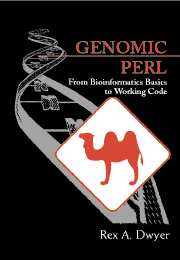Book contents
- Frontmatter
- Contents
- Preface
- Acknowledgments
- 1 The Central Dogma
- 2 RNA Secondary Structure
- 3 Comparing DNA Sequences
- 4 Predicting Species: Statistical Models
- 5 Substitution Matrices for Amino Acids
- 6 Sequence Databases
- 7 Local Alignment and the BLAST Heuristic
- 8 Statistics of BLAST Database Searches
- 9 Multiple Sequence Alignment I
- 10 Multiple Sequence Alignment II
- 11 Phylogeny Reconstruction
- 12 Protein Motifs and PROSITE
- 13 Fragment Assembly
- 14 Coding Sequence Prediction with Dicodons
- 15 Satellite Identification
- 16 Restriction Mapping
- 17 Rearranging Genomes: Gates and Hurdles
- A Drawing RNA Cloverleaves
- B Space-Saving Strategies for Alignment
- C A Data Structure for Disjoint Sets
- D Suggestions for Further Reading
- Bibliography
- Index
3 - Comparing DNA Sequences
Published online by Cambridge University Press: 05 June 2012
- Frontmatter
- Contents
- Preface
- Acknowledgments
- 1 The Central Dogma
- 2 RNA Secondary Structure
- 3 Comparing DNA Sequences
- 4 Predicting Species: Statistical Models
- 5 Substitution Matrices for Amino Acids
- 6 Sequence Databases
- 7 Local Alignment and the BLAST Heuristic
- 8 Statistics of BLAST Database Searches
- 9 Multiple Sequence Alignment I
- 10 Multiple Sequence Alignment II
- 11 Phylogeny Reconstruction
- 12 Protein Motifs and PROSITE
- 13 Fragment Assembly
- 14 Coding Sequence Prediction with Dicodons
- 15 Satellite Identification
- 16 Restriction Mapping
- 17 Rearranging Genomes: Gates and Hurdles
- A Drawing RNA Cloverleaves
- B Space-Saving Strategies for Alignment
- C A Data Structure for Disjoint Sets
- D Suggestions for Further Reading
- Bibliography
- Index
Summary
The human genome comprises approximately three billion (3 ×109) base pairs distributed among 23 pairs of chromosomes. The Human Genome Project commenced in the 1990s with the primary goal of determining the sequence of this DNA. The task was completed ahead of schedule a few months before this book was completed.
Scientists have been anxious to remind the public that the completion of the Human Genome Project's massive DNA sequencing effort will hardly mark the end of the Project itself; we can expect analysis, interpretation, and medical application of the human DNA sequence data to provide opportunities for human intellectual endeavor for the foreseeable future.
It is equally true, though less well understood, that this milestone in the Human Genome Project will not mark the end of massive sequencing. Homo sapiens is just one species of interest to Homo economicus, and major advances in agricultural productivity will result from ongoing and new sequencing projects for rice, corn, pine, and other crops and their pests. Because of the large differences in size, shape, and personality of different breeds, the Dog Genome Project promises to bring many insights into the relative influences of nature and nurture. Even recreational sequencing by amateur plant breeders may not lie far in the future.
- Type
- Chapter
- Information
- Genomic PerlFrom Bioinformatics Basics to Working Code, pp. 30 - 43Publisher: Cambridge University PressPrint publication year: 2002

